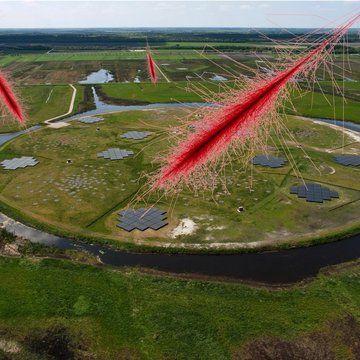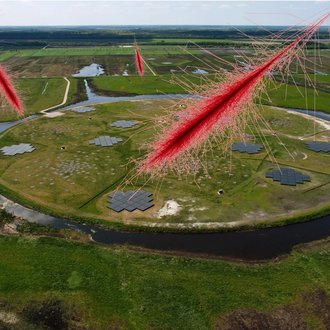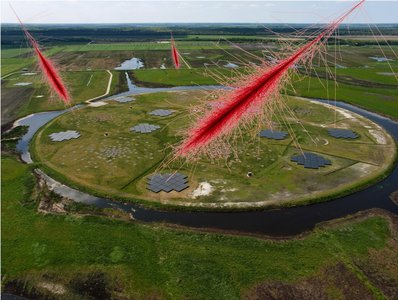Radio detection of cosmic rays
LOFAR, the Low-Frequency Array Radio Telescope, observed ultra-short, bright radio pulses of elementary particles entering the Earth atmosphere at almost the speed of light. The particles were fired off by a cosmic accelerator millions of years ago. An international team of astronomers including a number of scientists from the German Long Wavelength consortium (GLOW) have now unraveled the radio code of these intruders to determine their nature and constrain their origin. Their results are published in today’s edition of Nature.
Cosmic rays are the highest energy particles found in nature. Air showers by cosmic rays generate radio emission, which can be recorded by LOFAR in an unprecedented way. The study of these continuous air shower records reveals a substantial light mass component in cosmic rays in the energy range 10^17 - 10^18 eV. The data shows an additional Galactic cosmic ray component dominating in the energy range below 10^17.5 eV. These important results have been published in the world wide famous journal "Nature". It is a result of LOFAR's Key Science Project "Cosmic Ray".
The Leibniz-Institut fuer Astrophysik Potsdam (AIP) contributed to this result with providing the basis radio data for this study from its own LOFAR station as a part of the International LOFAR Telescope.
The AIP as a member of the ILT participates in LOFAR's operations with its own LOFAR station in Potsdam-Bornim. LOFAR (LOw Frequency ARray) is presently the most advanced radio telescope at low frequencies (10 - 240 MHz) in the world. It was originally designed by ASTRON in the Netherlands. It consists of 24 stations in the core near Exloo (NL) and 14 remote stations spread out all over the Netherlands. Additionally, there are 12 international stations in France, Germany, Poland, Sweden, and UK.
The radio signals recorded at these individual stations are transferred via a high date rate link of about 10 GBit/s to Groningen (NL) where they are correlated to a radio map of the sky. Now, LOFAR is operating as an European radio telescope in terms of ILT. The science with LOFAR is managed in term of key science projects (KSP). One of them, the KSP "Solar Physics and Space Weather with LOFAR" is coordinated by AIP.
Press release published by the Max Planck Institute for Radio Astronomy (MPIfR):
http://www.mpifr-bonn.mpg.de/pressreleases/2016/6
Publication: “Radio Detections of Cosmic Rays Reveal a Strong Light Mass Component at 10^17 - 10^17.5 eV,” S. Buitink et al., 2016 March 3, Nature http://www.nature.com
LOFAR, the Low-Frequency Array Radio Telescope, observed ultra-short, bright radio pulses of elementary particles entering the Earth atmosphere at almost the speed of light. The particles were fired off by a cosmic accelerator millions of years ago. An international team of astronomers including a number of scientists from the German Long Wavelength consortium (GLOW) have now unraveled the radio code of these intruders to determine their nature and constrain their origin. Their results are published in today’s edition of Nature.
Cosmic rays are the highest energy particles found in nature. Air showers by cosmic rays generate radio emission, which can be recorded by LOFAR in an unprecedented way. The study of these continuous air shower records reveals a substantial light mass component in cosmic rays in the energy range 10^17 - 10^18 eV. The data shows an additional Galactic cosmic ray component dominating in the energy range below 10^17.5 eV. These important results have been published in the world wide famous journal "Nature". It is a result of LOFAR's Key Science Project "Cosmic Ray".
The Leibniz-Institut fuer Astrophysik Potsdam (AIP) contributed to this result with providing the basis radio data for this study from its own LOFAR station as a part of the International LOFAR Telescope.
The AIP as a member of the ILT participates in LOFAR's operations with its own LOFAR station in Potsdam-Bornim. LOFAR (LOw Frequency ARray) is presently the most advanced radio telescope at low frequencies (10 - 240 MHz) in the world. It was originally designed by ASTRON in the Netherlands. It consists of 24 stations in the core near Exloo (NL) and 14 remote stations spread out all over the Netherlands. Additionally, there are 12 international stations in France, Germany, Poland, Sweden, and UK.
The radio signals recorded at these individual stations are transferred via a high date rate link of about 10 GBit/s to Groningen (NL) where they are correlated to a radio map of the sky. Now, LOFAR is operating as an European radio telescope in terms of ILT. The science with LOFAR is managed in term of key science projects (KSP). One of them, the KSP "Solar Physics and Space Weather with LOFAR" is coordinated by AIP.
Press release published by the Max Planck Institute for Radio Astronomy (MPIfR):
http://www.mpifr-bonn.mpg.de/pressreleases/2016/6
Publication: “Radio Detections of Cosmic Rays Reveal a Strong Light Mass Component at 10^17 - 10^17.5 eV,” S. Buitink et al., 2016 March 3, Nature http://www.nature.com
Images
Image of air showers over a LOFAR station.
Big screen size [1000 x 753, 180 KB]
Original size [1019 x 768, 180 KB]





